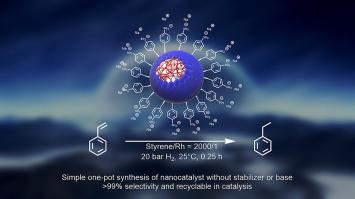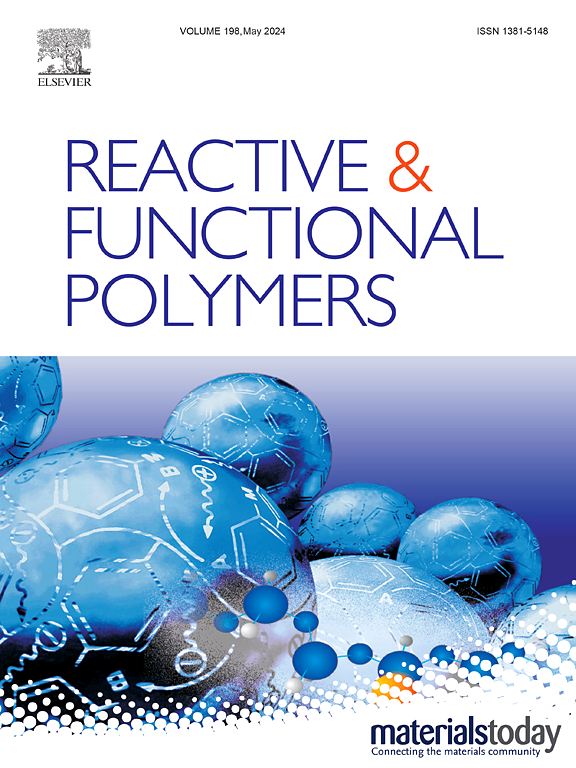Rh nanoparticles confined in triphenylphosphine oxide-functionalized core-crosslinked micelles with a polyanionic shell: Synthesis, characterization, and application in aqueous biphasic hydrogenation
IF 4.5
3区 工程技术
Q1 CHEMISTRY, APPLIED
引用次数: 0
Abstract
Core-crosslinked micelles (CCMs) with a hydrophilic polyanionic shell made of poly(sodium styrene sulfonate) chains, P(SS−Na+), a triphenylphosphine oxide-functionalized polystyrene core (TPPO@PSt) and crosslinked at the inner end of the polystyrene chains by diethylene glycol dimethacrylate (DEGDMA) were synthesized by reversible addition-fragmentation chain-transfer (RAFT) polymerization as a stable TPPO@CCM-A latex. One-pot synthesis of rhodium nanoparticles (RhNPs) by the reduction of [Rh(COD)(μ-Cl)]2 in the aqueous TPPO@CCM-A latex yielded a stable RhNP-TPPO@CCM-A latex without the need of additional stabilizer or base. This Rh-loaded latex was applied to the catalytic biphasic hydrogenation of styrene under mild conditions with complete selectivity towards ethylbenzene and corrected turnover frequencies (cTOFs) ranging from 3250 to 10,010 h−1 based on the surface atoms of the RhNPs. Importantly, the catalytic phase proved recyclable after product extraction, owing to the efficient retention of the RhNPs by the core TPPO ligands.

封闭在具有聚阴离子外壳的三苯基膦氧化物功能化核心交联胶束中的 Rh 纳米粒子:合成、表征及在水性双相氢化中的应用
核心交联胶束(CCMs)具有由聚(苯乙烯磺酸钠)链(P(SS-Na+))构成的亲水性聚阴离子外壳、通过可逆加成-断裂链转移(RAFT)聚合反应合成了稳定的 TPPO@CCM-A 胶乳。通过在 TPPO@CCM-A 胶乳水溶液中还原 [Rh(COD)(μ-Cl)]2 来一锅合成铑纳米粒子 (RhNPs),无需额外的稳定剂或碱即可得到稳定的 RhNP-TPPO@CCM-A 胶乳。这种负载了 Rh 的胶乳被用于在温和条件下催化苯乙烯的双相加氢反应,对乙苯具有完全的选择性,根据 RhNPs 的表面原子,校正周转率(cTOFs)从 3250 h-1 到 10 010 h-1 不等。重要的是,由于核心 TPPO 配体对 RhNPs 的有效保留,催化阶段在提取产物后证明是可回收的。
本文章由计算机程序翻译,如有差异,请以英文原文为准。
求助全文
约1分钟内获得全文
求助全文
来源期刊

Reactive & Functional Polymers
工程技术-高分子科学
CiteScore
8.90
自引率
5.90%
发文量
259
审稿时长
27 days
期刊介绍:
Reactive & Functional Polymers provides a forum to disseminate original ideas, concepts and developments in the science and technology of polymers with functional groups, which impart specific chemical reactivity or physical, chemical, structural, biological, and pharmacological functionality. The scope covers organic polymers, acting for instance as reagents, catalysts, templates, ion-exchangers, selective sorbents, chelating or antimicrobial agents, drug carriers, sensors, membranes, and hydrogels. This also includes reactive cross-linkable prepolymers and high-performance thermosetting polymers, natural or degradable polymers, conducting polymers, and porous polymers.
Original research articles must contain thorough molecular and material characterization data on synthesis of the above polymers in combination with their applications. Applications include but are not limited to catalysis, water or effluent treatment, separations and recovery, electronics and information storage, energy conversion, encapsulation, or adhesion.
 求助内容:
求助内容: 应助结果提醒方式:
应助结果提醒方式:


